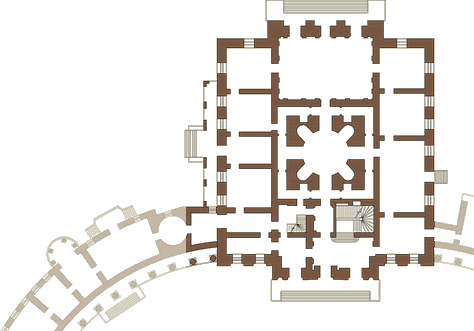The Ball Room
Загрузка панорамы...
A corner hall of the ground floor in the northern part of the central building, decorated by Charles Cameron in 1784-1787. Three original designs by Charles Cameron have been preserved: the south wall, frieze, and plafond. The room was intended for small-scale dance evenings and music playing. According to Cameron's original plan, mirrors and brackets with candles were placed on the walls, adding volume and light to the room. After the fire of 1803, the room was restored to its former state, except for its windows, enlarged for better illumination.
At the request of the Dowager Empress Maria Feodorovna, the hall was converted into a Dining Room in 1815. The mirrors and brackets were removed and replaced with four paintings transported from the St. Michael's Castle. This series of paintings was executed by the famous French painter Hubert Robert, who was called the “artist of ruins”, commissioned by Pavel Petrovich and Maria Feodorovna during their trip abroad. Initially ordered for the Kamennoostrovsky Palace, under Pavel Petrovich, the paintings were moved to the Gatchina Palace, then, for a short time, to the St. Michael's Castle, and, after the death of Emperor Paul I, Maria Feodorovna finally moved them to Pavlovsk, where the Ball Room was converted to accommodate them, becoming the Dining Room. In 1824, under the chief architect Carlo Rossi, the Dining Room was connected to the adjacent Living Room, so a large arch was made in the western wall. At the same time, a vault was erected, covering the elegant Cameron's frieze. In 1858, the owner of Pavlovsk, Grand Duke Konstantin Nikolaevich, turned this room into a large Reception Room.
In the post-war years, based on the developed scientific method of restoration, a project was created, considering the original authentic finishing details preserved on the walls: the frieze was uncovered, allowing the restorers to return the appearance of the late 18th–early 19th century. The pattern of the stucco frieze around the perimeter of the walls is especially characteristic of the work of Charles Cameron: thin gilded molding in the form of stylized branches and classical vases gives the hall sophistication when combined with the pinkish-blue color scheme of the walls. The molding of the overdoor with the motifs of antique vases follows the same style. A stucco gilded garland on the plafond creates a peculiar frame for an elegant multi-tiered chandelier made of gilded bronze with crystal decor and ruby glass (Saint Petersburg, the 1790s).
Just like in the time of Empress Maria Feodorovna, the walls are once again decorated with paintings by French artist Hubert Robert: Collection of Ancient Monuments of France, 1785 (to the right of the fireplace), Collection of Ancient Monuments of Rome, 1786 (to the left of the fireplace), The Burning of Rome, 1785 (left end wall), The Triumphal Bridge (right end wall). In 1785, the paintings Collection of Ancient Monuments of France and The Burning of Rome were exhibited at the Paris Salon as the property of Count Du Nord (Pavel Petrovich's incognito during the journey of 1781–1782), arousing the great interest of the public and critics.
French artistic bronze ware of the late 18th–early 19th centuries is represented on the mantelpiece. In the center, is an elegant clock in the form of a portico, made of white marble with an openwork decoration of gilded bronze (Paris, the 1780s). The clock drum is installed between two four-sided columns, topped by two classical vases with erupting flames. Above the dial is an arrangement of a torch and a quiver with arrows. At the foot of the columns on the ledges are porcelain medallions: the finest figures of Apollo, Fortune, Cupid, and Psyche on a blue background. So, the motifs of the allegory of love are used in the decoration of the clock. Of particular note are the trivets at the bottom of the fireplace in the form of female figures in antique chitons, made in the workshop of Pierre-Philippe Thomire (Paris, the 1790s). These purely utilitarian firewood stands were turned into works of art.
Opposite the fireplace, on white carved consoles made per Vincenzo Brenna's drawings (1799), there are elegant gilded bronze candelabra in the form of vases with bouquets of lilies (Paris, master Pageau, 1770–1780), and between them are the 18th-century Japanese porcelain vases, which remained fashionable decorative elements for a century.
The Ball Room on the floor plane
- The Raspberry Study
- The Common Study
- The New Study
- The Corner Drawing Room
- The White Dining Room
- The Billiards Room
- The Old Drawing Room
- The Ball Room
- The French Room
- The Dark Pantry

Back
